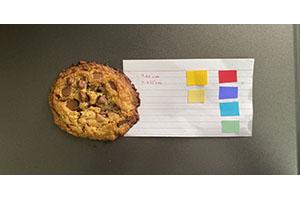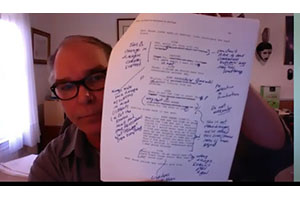On Campus
AU Professors Find Innovative Ways to Teach Online

Cookie and RGB (red, green, and blue) analysis data from online cooking with chemistry class. Photo credit: Arianna Lopez, CAS/BS ‘20
Teaching online in the wake of the COVID-19 pandemic became as simple (and complicated) as a chocolate chip cookie for College of Arts and Sciences chemistry professor Matt Hartings.
Hartings is among the 936 full-time tenured, tenure-track, and term faculty and more than 500 adjunct instructors who quickly figured out how to move American University’s 3,018 traditional classes online for 8,163 undergraduates in March.
Provost Dan Myers praised the efforts of faculty as they figured out how to address the needs of their students amid this unprecedented situation.
“People across the university have really been amazing,” he says. “The collective spirit and hard work over the past few weeks have been really unbelievably impressive. It is a real test for higher ed and the world. I feel that higher ed has really risen to the occasion and proved its worth in so many ways—and that positive impact is just beginning.”
The Center for Teaching, Research, and Learning (CTRL) partnered with the University Library’s E-Learning Support, Audio Visual Services, and Academic Technology Systems teams to create the Instructional Continuity Team, said CTRL executive director Kiho Kim. The team of 25 faculty and staff conducted 11 workshops to teach the basics of the university’s online learning tools to about 600 faculty who had not taught online before. A rapid response team also was available for 12 hours a day to provide support while professors were amid their first two weeks of teaching online.
“The faculty really saw the importance of maintaining the instructional continuity for the students,” Kim said.
Take Hartings, who applied principles from his popular cooking with chemistry class and turned the home kitchens of his chemistry and biochemistry lab students into their own laboratories, where every Tuesday and Wednesday they measure ingredients by mass following Nestle’s popular Toll House cookie recipe to create a single chocolate chip cookie.
“The tricky part is, that recipe calls for two eggs,” Hartings says. “But how do you do two eggs when you’re just making a single cookie, right? We have them take an egg, scramble it all up, whisk it all together, and measure it by mass—the fraction of the two eggs that instead of going into 30 cookies is just going into one cookie.”
Then, the students take photos before and after the cookie is baked with their smartphones and determine optimal baking time by analyzing its browning properties using RGB (red, green, and blue) analysis. The goal of the lab is to have the students think critically about the design of their experiments, so they can normalize and analyze their data, Hartings explains.
Teaching a student body that is logging into class from 16 different time zones means faculty have to turn what had been “synchronous” teaching experiences that work for traditional classes into “asynchronous” experiences with presentation materials that can be accessed at different times, says School of International Service lecturer Terra Gargano, who teaches intercultural communication classes, as well as best-practices workshops about online teaching for CTRL.
Gargano says the transition to the virtual teaching space creates three basic questions for faculty: how to facilitate class discussion online, how to make online learning engaging for students, and how to engage students in active learning through the use of breakout rooms and other technologies.
“There’s an opportunity here for us to learn how we can utilize the technology and the pedagogy that we employ in a virtual space in the traditional campus classes,” Gargano says. “And it’s also going to make all of us better teachers.”
Many AU professors are doing their best to embrace the technology that allows them to continue teaching their students this semester like Bradley Hardy, a professor of public administration and policy in the School of Public Affairs.
“Once you realize that nobody can engage face to face, you become far more acquainted with other ways to do that,” Hardy said. “I have been really pleased with the tools on Blackboard Collaborate, which gives me the ability to hold a video lecture and share my slides. I still hold a lecture every week, and I’m doing more with online discussion forums. I’m still trying to learn. I don’t claim to have this fully worked out. But it has been good in terms of the tools the university has.”
School of Communication lecturer John Weiskopf took that opportunity to convert his regular class schedule into synchronous sessions for sharing short clips of films and television shows over the Zoom videoconferencing app. He also holds one-on-one script critique sessions with his screenwriting students in his Zoom room. Students send him their scripts, which he grades and comments on, and they talk through his observations.

The class meets en masse once a week via Zoom to evaluate the script structures of television shows like Six Feet Under and films like Joker and Parasite and talk about their work as a group.
“I actually like it,” Weiskopf said of this new normal. “It’s a lot more work. I’m working long days. I make a lot of money as a film consultant, and I have a project I haven’t been able to get to because I’ve been doing this, but that’s okay. It really makes your life rich. That is why I love teaching, and that's why I love AU.”

